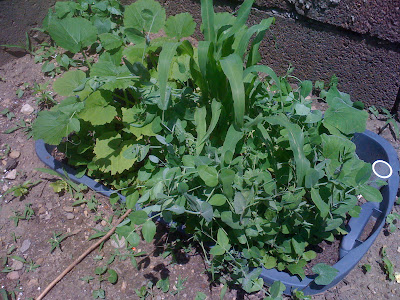Harvest

It is a new and wonderful feeling for me, of holding food that I grew still warm from the sun in my hand. I love going down into my garden and squatting amongst the rampant greens, the wandering squash vines, the upstretched cornstalks, the wandering tomato branches, poking and prodding at the growing shapes, frowning over insect damage, cupping the reddening tomatoes in my hand.
We've already finished the lettuce crop, but now we are harvesting corn and tomatoes every few days, and we've got all the basil and rosemary that we can use. The zucchini, and cucumbers haven't fruited yet, but there's one little nubbin of a winter squash that's ripening now. There are two yellow peppers that are ust hanging out, waiting until figure they're ripe. Since I'm a beginner, I really don't know when things are ready. It's a little hard to tell. They're not necessarily the same varieties that you buy at teh supermarket, so I don't exactly know what they're supposed to look like and feel like when they're ready.
My downstairs neighbors are the ones who have access to the yard, but early this spring we were chatting about our shared interest in organic gardening, and they said, "you know, we're really only going to use half of it. The weedpatch on the right? Have your way with it." And we were off.
My tubs are chaotic and wild, the plants reaching out in every direction, hungry for more space and sun. There's a massive native population of bindweed, also known as Morning Glories, that are constantly reaching up and twining around each other and anything else they can reach, but fortunately, their roots are not established inside my tubs. My plants are doing wonderfully.

We're using these tubs called "earthboxes", which is just a plastic tub with a perforated extra floor in it that serves as a water reservoir. You cut the bottom off of a second tub and set the bottom piece upside down into the bottom of your first tub. Now you have an elevated floor in your first tub. Into this new floor, drill a bunch of holes so water can pass up and down. In the corner of the raised floor, drill a big hole that will accommodate a 1 1/2" PVC pipe. Now around the side walls of the main tub, drill a belt of holes. These are overflow holes so that when you fill the tub with water, you cannot overfill it, and the overflow will run out these side holes. Fill it up with nice dirt that's got lots of compost and manure in it, and you're finished. They work wonderfully. You don't have to water anywhere near as often, and your plants are assured a steady water supply. This is particularly good if you're growing something that's water-intensive such as tomatoes.
This is the same tub pictured above when it started, on April 30. It's pretty marvelous seeing your plants go from dirt and seeds to verdant explosion.

And in May:

Something keeps eating my peas and beans, I'm not sure what. It turns the leaves into a lacy latticework of veins, eating all the soft leaf tissue between the veins. Anyone know what that is?
Labels: brooklyn soil, corn, DIY, earthbox, gardening, insect damage, lettuce, organic, raised bed gardening, tomatoes, urban gardening, zucchini

